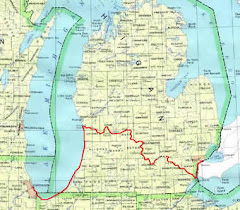I have received an Email from Valerie. She is reading these in her hospital room. I am so pleased and moved.. Further down the Wabash after Lafayette/West Lafayette you pass the towns of Independence, Attica, Covington, Perryville, Montezuma and Clinton. The terrain to the west gets hilly but the Krugers wouldn't notice much down at river level. Neither would they see much of the occasional big gravel operations. Between Perryville and Montezuma the Vermilion and Little Vermilion Rivers come in from the west and Sugar and Big Raccoon Creeks come in from the east. Confluences of tributaries are always obvious at river level. A bigger and more historic town is Terre Haute, French for High Land for the prominent plateau the city sits on. Terre Haute is the home of Indiana State University where Larry Bird played basketball, and a Federal Prison that sometimes does executions. In the steamboating days Terre Haute was nicknamed "Sin City", famous for its Redlight District along the riverfront. For a less smartass description, see Wikipedia. About 20 or so miles below Terre Haute the Wabash becomes the state line between Indiana and Illinois. I don't see any "Welcome" signs that one usually sees at state lines. In places where an oxbow has been cut off by man or nature the state line invariably follows the old oxbow. Next is the little town of Darwin on the Illinois side. Here is the last ferry operating on the Wabash River. It is mostly used by Illinois farmers to get the their Indiana fields. Just above Vincennes the riverside property lines change from the American survey quadrangular system to the old French ribbon farm system whereby the farms are laid out perpendicular to the river. Vincennes....you wouldn't believe how much history this old town has, ancient Indian, Indian, French, British, American....you should look it up. My late wife Elaine and I visited here in 1979 (how do I know the year? We were driving our 1978 Chrysler LeBaron, the fanciest car we ever owned, all leather seats with an 8-track sound system playing the "Theme from Rocky"). We were impressed by the George Rogers Clark Memorial which looks like something from the Mall in Washington, D.C. parked on the banks of the Wabash. George Rogers Clark. Now there is a real American hero, who among many other valiant and incredible things, led American troops on a winter-time expedition by canoe and wading in swamps in a surprise attack on the British at Vincennes during the Revolutionary War. You really should look him up. On another punitive expedition, Major Jean Francois Hamtramack (yeah, the guy for which the Detroit enclave is named) led his American troops and some local French militia up the Wabash against a Kickapoo Indian force supposedly camped at the Vermilion and Eel Rivers. They couldn't find any so they returned. "Hamtramack against the Kickapoo", I couldn't resist. I'm sure they didn't think it was so funny. You don't have to look that one up...... The Embarras River flows in from Illinois between Vincennes and St. Francisville. The name comes from French explorers who used the term for river obstacles like logjams. Continuing downriver past St. Francisville the Krugers would have arrived at Mt.Carmel where the White and Patoka Rivers come in from the east. In the spring of 2008 Mt. Carmel was at the epicenter of a 5.2 magnitude earthquake that was felt all the way to St. Louis. Next downriver is New Harmony, the site of two historic utopian communities. You might want to look them up. The Little Wabash from Illinois joins the Big Wabash just a few miles above its confluence with the Ohio River. Verlen: "Winter seemed to make one more effort to delay us the last few days of January on the lower Wabash River. The temperature dropped to near zero, the river became 90 per cent covered with broken ice, making travel impossible for a day, and rather difficult for several more days. On our last night on the Wabash, we camped among trees on a muddy lowland bank. It was a cold, still night and all night long we could faintly hear the low throb of diesel engines - the sounds of barges pushing up and down the Ohio River, about 15 miles away." Next: The Ohio. |

Thursday, December 17, 2009
Following Verlen and Valerie-VI-The Wabash continued
Subscribe to:
Post Comments (Atom)

No comments:
Post a Comment